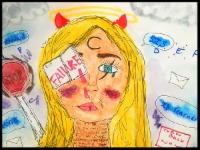Annie–Failure
Continuing with our summer “Youth Series” we asked Annabel, Gioia’s 16 year-old daughter, to do artwork in response to some of the directives we often give to our clients. We wanted a teenager’s perspective on those themes. She chose “Attending to the Good/Negativity Bias”, an exercise designed to address the natural tendency for negative experiences and perceptions to command our attention more than positive ones.
Annabel’s Take on The Negativity Bias
The negativity bias works like this: although it might not always seem like it, most of what is happening around us is uneventfully positive-so much so that we don’t have the attentional resources to consciously process all of this “goodness”. In order to make sense of everything that is coming into its purview, the mind takes shortcuts. It scans for anything that might be problematic because those things might signal a situation that needs to be managed.
The Metaphor of a Photograph
We often use the metaphor of a photograph to explain this phenomenon–the good forms the background of the image, it frames the picture but it is less distinct and may even go unnoticed; whereas difficulties, like the main subject, appear in the foreground more sharply and distinctly.
Create Artwork About Something That Is Bothering You
When we explore this with our clients in the art process, we often give a suggestion like “Create art about something which is bothering you and after finishing, see if visualizing the problem helped to find out positive things about it”. As we mentioned, Annie graciously agreed to create something for this theme. Above you can see her artistic response to that prompt.
Here Are Annie’s Thoughts on the Process:
The thing which originally came to my mind that bothered me was the stress of attempting to have good grades in school. I don’t think of myself as a strong drawer of people… or of anything, but I decided to draw myself for this directive. I used a pen to sketch a twisted version of myself with a scar across my eye, beaten up red cheeks, a bloody nose, stitches, a lip cut, and, to top it off, a small book with the word failure written in blood covering one of my eyes. To emphasize the thing which was bothering me most, I drew grades going across the page with the letter C in bold on my forehead– as one of my fears has been getting a C in school.:
Better Than Expected
Creating this directive turned out exceedingly better than I had expected. I had fun expressing my worries in a dramatic way. It made me feel better to visualize them. It felt therapeutic to draw out my worries. However, in the directive it does suggest creating the drawing might help to see positive aspects of the situation and although it felt good to express my worries, that didn’t happen for me.
The Power of Art Therapy
While Annie’s artwork, with its scars and bloodied bruises is, indeed, dramatic, it’s also a great example of the power of art therapy. Annie’s reflections on her process gives us insight into what someone her age might feel on the inside, and they helped her mom, Gioia, to understand Annie’s stressed-out feelings better.
Expressing Ourselves Gives Us Relief
Overall, though, the most compelling take away is that, not surprisingly, at its simplest, art helps us express ourselves. It gives us relief. And that, just by itself, is positive. Whether it overcomes the negativity bias may be less important than the therapeutic effect of just getting it out.
Positively yours, Annabel, Gioia, and Rebecca
Art Directive
Create art about something which is bothering you and after finishing, see if visualizing the problem helped to find out positive things about it.
